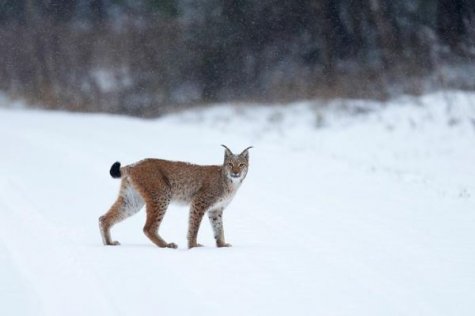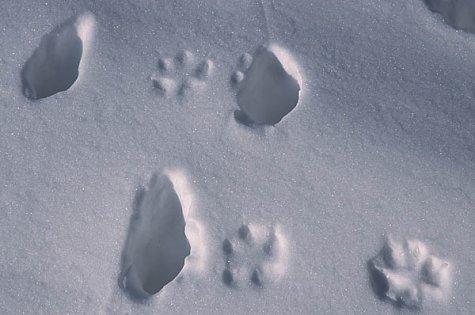Lynx couples observed
Photos: Sven Zacek and Arne Ader
Translation: Liis
| Lynx | Ilves | Felis lynx |
The territory of a single, mobile, fully grown male lynx is large, so there may be several “lady friends”, and all can’t be visited at the same time.
In Lääne-Virumaa tracks of a lynx couple were seen before the snowstorm, just at the beginning of their mating period.
The fur colour of this cat family (Felidae) member varies quite widely, but usually leaves a pale-coloured over-all impression in winter. The back and legs have dark spots – larger and placed wider apart on the back, denser on the legs. Sometimes the spots make up strange patterns. The ears have brush-like tufts like those of the squirrel; the tail is short, broad and black-tipped.
In thick snow these predators pursue their prey from dense copses bordering on cultured areas, where the flocks of deer and their movements can be observed.
Lynxes lead a rather secretive life, and aren’t easily seen by people, but in the mating period there is a considerably better chance to meet them. A lynx hides its prey carefully in the snow: the reason is that if the observant ravens were to discover it, there may be nothing to be had a few days later. Other signs of activity are carefully hidden too: excrements are for instance buried, only the tracks can be read by those who know how to.
In winter the paws are covered by fur which increases the area that carries the lynx on snow. As cats do, they usually move with the claws retracted, so the paw mark looks large and rounded.
In Lääne-Virumaa tracks of a lynx couple were seen before the snowstorm, just at the beginning of their mating period.
The fur colour of this cat family (Felidae) member varies quite widely, but usually leaves a pale-coloured over-all impression in winter. The back and legs have dark spots – larger and placed wider apart on the back, denser on the legs. Sometimes the spots make up strange patterns. The ears have brush-like tufts like those of the squirrel; the tail is short, broad and black-tipped.
In thick snow these predators pursue their prey from dense copses bordering on cultured areas, where the flocks of deer and their movements can be observed.
Lynxes lead a rather secretive life, and aren’t easily seen by people, but in the mating period there is a considerably better chance to meet them. A lynx hides its prey carefully in the snow: the reason is that if the observant ravens were to discover it, there may be nothing to be had a few days later. Other signs of activity are carefully hidden too: excrements are for instance buried, only the tracks can be read by those who know how to.
In winter the paws are covered by fur which increases the area that carries the lynx on snow. As cats do, they usually move with the claws retracted, so the paw mark looks large and rounded.
Carries - or not? Lynx tracks.










